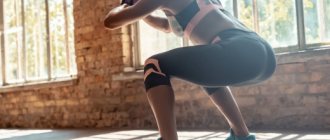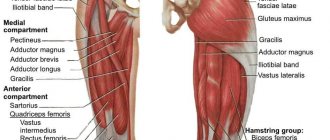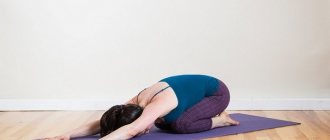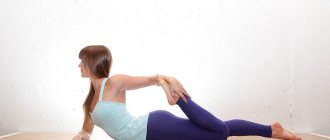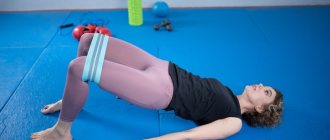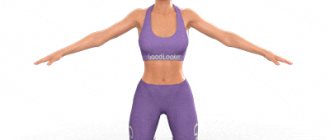Supta Baddha Konasana is translated from Sanskrit as “leaning back corner pose . There is also a more interesting name for this exercise - “lying butterfly pose”; outwardly, the asana has a certain similarity with this name. This is a suitable pose for relaxing the body and mind, while at the same time it tones the body. The particular benefits of the asana have been noted in the rehabilitation therapy of the pelvic and abdominal organs. This is a variation of the full Baddha Konasana pose.
Technique for performing Baddha Konasana
Even beginners can begin mastering this asana, since it is not particularly difficult. The baddha konasana technique boils down to the fact that it must be performed in a sitting position. Baddha konasana is performed while sitting on a flat surface, while the legs must be moved as close to you as possible, in the so-called butterfly pose.
This position is achieved by connecting the heels and full feet of the legs. You can hold your legs with your hands, grasping the ankle or feet and pulling them as close to you as possible. The legs resemble the wings of a butterfly.
The hips are lowered as low as possible to the floor, preferably with the knees touching the floor. The execution time for this technique is from 30 to 60 seconds. Breathing should remain even, no sudden movements should be made and the asana should not be performed too intensely so as not to cause harm.
The spine must be kept vertical, with the back fully extended and as straight as possible. Try to connect the shoulder blades to each other. Hands are either on the feet or on the shins. The stomach is pulled in, the abs are tense.
During the exercise, you can feel the tension in the ligaments and muscles of the legs. This is how it should be, but since people's legs can be stretched unevenly, the stretch may be felt more strongly in one leg. Over time, this feeling passes and the symmetry of the body will be felt.
There is also a variation of the pose. It is called supta baddha konasana. The position has an extremely beneficial effect on human health, as it improves muscle elasticity, joint flexibility, normalizes blood circulation and improves blood circulation.
It is performed using some elements. You need to take a roller about 50 cm long, a blanket, a yoga belt and 2 bricks.
A blanket is placed on the bolster, with bricks on the sides. Sit on the blanket with your back to the bolster, close your legs together, bend your knees, move them as close to your groin as possible. Fasten the belt and throw it behind your back. Lower it just below the lower back and pull it over your feet. The belt will help pull your feet closer to you. Lowering yourself onto the cushion with your back, place your elbows on the blanket, palms up. The head should be positioned straight and the back should be straight.
Place bars under your knees for convenience if you don’t have the appropriate stretch. If the body's capabilities allow, then you can do without bricks. In the pose you need to relax and feel the opening of each chakra.
It has a very good effect on the female body, as it improves blood circulation in the pelvis. This asana can be performed even by women during menopause.
Variations
Lightweight
You can perform this pose by resting your feet on the surface of the wall. Before the exercise, it is recommended to place a rolled-up blanket under your back, the edge of which is located exactly under the sacrum. This allows the body to relax and reduce tension in the pelvic area.
If you experience pain or discomfort in the hip joints, you can place something soft under your hips before performing this asana.
Complicated
Suitable for both versions (full or light): straighten your arms behind your head (palms “look” at each other), stretch after your arms, expanding your chest as much as possible, stretching your stomach and ribs.
The effect of performing the butterfly pose
Baddha konasana is recommended for almost every person. Its effectiveness is many times higher if a person can relax during the session. The butterfly pose has a beneficial effect on blood circulation, normalization of blood pressure, the functioning of the pelvic organs, as well as the digestive tract.
At the same time, even those who suffer from kidney diseases note the positive effects of this asana. It can also be performed by people with spinal problems. The butterfly pose has a positive effect on the spine even with hernias and osteochondrosis. Regular performance of this asana allows you to open the pelvis, thereby making it easier for a woman to give birth in the future.
Even pregnant women can perform this, but caution must be exercised.
Can it be done by pregnant women?
This asana is recommended for pregnant women at any stage. The fact is that it has a good effect on the condition of the hip joints, which play an important role in the childbirth process.
The “butterfly” also contributes to:
- reducing the manifestations of varicose veins;
- normalizes hormonal levels;
- reduces uterine tone;
- helps enrich the pelvic organs with blood.
It was noticed that those women who regularly performed the asana felt more confident during childbirth, and the latter went faster and without complications.
In the later stages, due to a large belly, it will not be possible to fully perform the second version of the “butterfly”, but performing breathing exercises in a sitting position is useful.
Benefit
The benefits of baddha konasana are very great for the body. It improves digestion, enhances metabolic processes in the body, tones the kidneys, improves blood pressure, and also helps improve reproductive function in both women and men.
The butterfly pose in yoga is especially recommended for those who want to normalize their menstrual cycle and improve the health of the reproductive system. At the same time, people suffering from radiculitis need to perform baddha konasana as often as possible, since it is an excellent prevention of this problem.
Women who take baddha konasana at least two to three times a week relieve themselves of problems with conception and the genitourinary system. Baddha Konasana is also called cobbler's pose. The name comes from the fact that Indian shoemakers work on the floor in this position.
Position adjustment
In order for the butterfly pose to be methodically correct, it is important to pay attention to the following points:
- stretch your back in the direction from the tailbone to the crown;
- pull up the stomach and chest;
- lower your chin slightly;
- move your elbows back;
- straighten your shoulders and spread them to the sides, pull your shoulder blades in;
- place the hips on the surface;
- Press the calf muscles well to the inner thigh.
It is important to actively pull your back, neck and crown upward.
When your feet turn upward, use your hands to try to pull your knees toward the floor. In the early stages, one knee will be higher than the other, so the inguinal ligaments will stretch unevenly.
The knee that is higher needs to be pulled down more. In a lying position, it is important to grasp your feet well with your hands, this makes it easier to lift your torso.
You cannot bend your back, raise your shoulders to your ears, or press your hands into your hips.
Possible mistakes
The effect of the pose can be achieved only if the technique of this asana is performed correctly. There are some common mistakes that are mostly made by beginners. Therefore, you should take at least two lessons from a professional to avoid them. Common mistakes are:
- Clamp in the shoulder area. The shoulders should be open and the shoulder blades should be brought together.
- Rounding the back. The back should be as flat as possible, the spine resembles a vertical straight line, the top of the head tends upward.
- Sagging of the body. To prevent this mistake, you can help the body push off the floor with your hands, while pointing the top of your head up.
All mistakes can be easily corrected, but if you regularly perform the asana incorrectly for a long time, this can have a detrimental effect on the health of the spine, since it bears a large load during baddha konasana.
Easing the asana
For beginners, at first you need to do easier versions of the pose. For this purpose, the following options are made:
- A block or folded blanket is placed under the buttocks.
- If you cannot grab your feet with your hands, you need to grab your ankles and use a belt.
- If you cannot keep your back straight, you can do the asana near the wall, focusing on it.
Warm-up, preparation for practice and breathing during practice
Where to start practicing yoga at home? Start with a warm-up. Easy preparation for asanas includes gymnastics for joints and warming up muscles. Basic yoga exercises for beginners include:
- turning the head left and right, bending forward and backward;
- circular movements with the arms bent at the elbow joint;
- rotation of the pelvis, tilting the whole body back and forth;
- back arching (within physical capabilities);
- circular movements of the knees.
After a general warm-up, you can begin working on specific muscle groups. Specific exercises include:
- swinging legs;
- push-ups in the “bridge” position;
- spinal rotations in a standing position;
- rolling on the heels;
- raising on toes;
- squats, etc.
The basics of yoga for beginners are based on breathing exercises. Practitioners learn how to move into and out of yoga poses. Breathing plays a big role when entering and exiting an asana. Breath control is based on the following principles:
- Backbends are performed while inhaling to open the chest. The starting position is assumed while exhaling.
- Twisting asanas begin with inhalation, during which the spine is stretched upward. The twist itself is performed while exhaling. Exit from twisting asana is performed while inhaling.
- when stretching a certain part of the body while inhaling, concentration of attention goes to the navel area, while exhaling - to the stretching area.
Reference
Experienced practitioners are able to hold their breath while performing exercises. But it is not recommended for beginners to do this. Without preparation, holding your breath can cause a sharp rise in blood pressure and loss of consciousness.
What are asanas and their effect on humans?
Asana is the structural unit of yoga. By asana is meant the position of the body in which the yogi achieves inner harmony. The elements of yoga make up a catalog of asanas or a so-called block. The following blocks of yoga asanas are distinguished:
- sitting poses;
- standing poses;
- lying poses;
- twists;
- back bends, etc.
Each block of asanas in yoga is designed for specific muscle groups, ligaments and tendons. Yoga asana complexes contain poses for both beginners and experienced practitioners. Hatha yoga involves simplified and traditional ways of performing the same exercise.
Hatha yoga asanas affect a person on three levels:
- Physical level. At the physiological level, asanas affect all systems of the body. Exercises help yogis maintain muscle tone and also work out ligaments and tendons.
- Energy level. Hatha yoga exercises open energy channels so that the yogi can receive energy flows. Literally everything matters - the speed of performing asanas, breathing, effort;
- Mental level. Asanas help the practitioner become aware of his mind and “hear” his body. In order for a dialogue with consciousness to occur, yogis follow a sequence of asanas.
Reference
Basic yoga asanas are intended for healthy practitioners who do not have any injuries or chronic illnesses. Any set of exercises for hatha yoga has its contraindications. For example, Virabhadrasana is prohibited for injuries of the knee joint.
Contraindications
You should not practice yoga if there is an exacerbation of inflammatory processes in the joints - arthritis, arthrosis. Knee injuries also limit movement, so it is necessary to wait for recovery and then use yoga techniques as rehabilitation.
Women who have been diagnosed with uterine prolapse or prolapse should also not perform this exercise. Can be performed for hernia of the spine and abdominal cavity, but with caution.
